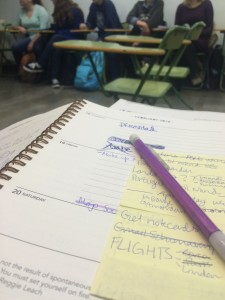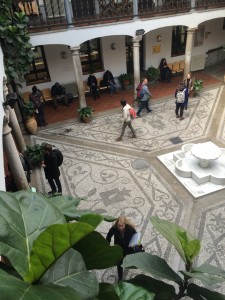To those wanting to study abroad in Spain, and are intimidated by the different school structure: never fear. Although the professors, format, coursework, building, really everything—right down to the language—is different, it is a new and refreshing change from American school.
Maybe it’s because I’m only taking 12 hours instead of my usual American 18 or so, or because I don’t have class before 10 a.m., or that the walk to school is only 10 minutes and through a city that never ceases to amaze me, but Spanish school has been better for me, a new way to learn, and just a whole new experience than classes back home.
 |
| My walk home from school, through a narrow alley on the way to the main road. |
For one, classes are an hour and a half long, but feel much faster if you get into the class, pay attention, and really listen to the professor. In my Islamic Culture in Spain class, for example, an hour and a half flies by. Our professor encourages us to participate “sin miedo, jovenes!” (without fear, students!), so the interaction makes the long class more fun. We’re encouraged to speak up, offer up answers even if they’re wrong, or just generally get involved in class. It’s a nice change from huge American lectures to a lively, enthusiastic discussion.
 |
| A quick picture of my view in class, sticky note lists and all |
Spanish schools much more relaxed about the flow of class in general. The “syllabus” we receive at the beginning of the course simply said we can’t miss more than 20% of our classes, gave a brief outline of what we would be learning, and noted the dates of the midterm and final exams. This is quite different from the pages-long syllabi they give us back home, with day-by-day plans of curriculum and precise expectations. While this structure works for my learning style, it is quite different from the structured, exact course schedule back home, and took me by surprise when I first started. After getting into the groove of class, however, I've found that classes flow naturally through the given curriculum.
The coursework is also different: it’s practically nonexistent. Instead of the hours and hours of homework, readings, essays, or projects I have back home, I’ve been enjoying a mildly homework-free schedule. We’re graded, instead, on our in-class participation, our eventual test grades, and just how much we try in the class. This gives me an immense amount of free time to do independent research for my thesis (from my home university, not here!), explore the city, live like a Spaniard, and just enjoy school rather than spend time indoors doing homework.
The building is also beautiful--designed like a typical Arabic building--with a courtyard in the middle, fountain (never on, for some reason), and tiled floors--it's a really nice place to have class. The classrooms are also small--not like the giant lecture halls in America--and the building is small enough where it's not overwhelming. I found all my classes easily the first day, and recently discovered the computer lab and library, which are always nice and warm despite it being very chilly outside.
 |
| View from the upper balcony of the CLM |
I also have time to volunteer once a week for a couple hours, something I never expected to have the opportunity to do, but which I’m looking forward to, immensely. Starting next week, I’ll be teaching English to a six-year-old, hearing impaired girl every Wednesday. As someone who loves kids and loves volunteering, this is an amazing experience to have, and a good way to practice my Spanish in a non-academic setting (her family doesn’t speak English).
For the first time in years, I can actually say that I love going to school. This new structure of class is much better for me, although it was a bit of a shock to get used to it the first week. It’s just another reason I love my new life here in Spain!
Darby Hennessey is the Spring 2016 CEA MOJO Blogger in Granada, Spain. She is currently a junior at the University of Mississippi







